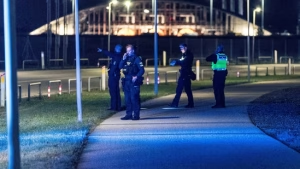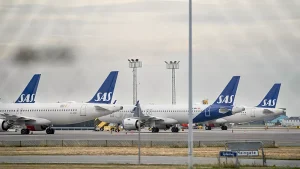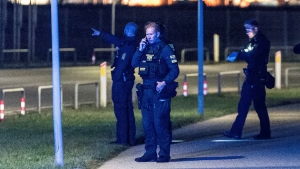Norway reported a significant aviation security incident when Oslo Airport drones were spotted over Oslo Gardermoen Airport, disrupting normal flight operations just hours after a similar incident forced the complete closure of Copenhagen’s Kastrup Airport. The Oslo Airport drones sighting has prompted immediate security responses and operational adjustments to ensure passenger safety.
The Oslo Airport drones incident represents the latest in a series of concerning aerial security breaches affecting Scandinavian aviation infrastructure. Officials at Oslo Gardermoen Airport confirmed that flight operations had been directly impacted due to the unauthorized drone activity, requiring immediate intervention and security protocols.
Immediate Security Response and Police Mobilization

Following the Oslo Airport drones sighting, heavy police presence was rapidly deployed to Oslo Gardermoen Airport as authorities launched an intensive search operation. Operations manager Gisle Sveen from the Eastern Police District confirmed that comprehensive measures have been implemented to locate the unauthorized aircraft and identify the drone operator.
“We have taken measures to try to locate this drone, but we have not yet been able to locate the drone pilot,” Sveen stated, highlighting the ongoing challenges in tracking the Oslo Airport drones and their operators. The police response demonstrates the serious security implications of unauthorized drone activities near critical aviation infrastructure.
Avinor’s Operational Adjustments and Safety Protocols


Avinor, Norway’s primary airport operations authority, immediately notified police following the Oslo Airport drones detection and implemented emergency safety measures. The organization made the critical decision to consolidate all air traffic operations to a single runway as a precautionary measure to maintain aviation safety standards.
Press officer Karoline Pedersen confirmed that despite the Oslo Airport drones disruption, air traffic continues to flow “smoothly and as normal” under the modified operational procedures. This adaptive response demonstrates the effectiveness of established emergency protocols for managing unexpected aerial threats while maintaining essential aviation services.
Connection to Broader Regional Security Concerns
The Oslo Airport drones incident occurred within a broader context of escalating aerial security concerns across Scandinavia. The Norwegian sighting followed closely after Denmark reported multiple large drones over Copenhagen, which resulted in the complete closure of Copenhagen’s Kastrup Airport until 9 AM local time Tuesday.
Prior to the Oslo Airport drones sighting, Norwegian authorities had already arrested two foreign nationals for operating drones within restricted military zones in central Oslo. These arrests provide crucial context for understanding the coordinated nature of unauthorized drone activities affecting Norwegian airspace and critical infrastructure.
Copenhagen Airport Closure and Regional Impact


The Oslo Airport drones incident represents the second major Scandinavian aviation disruption within hours, following the complete shutdown of Copenhagen Airport due to drone sightings. The Danish incident resulted in at least 100 flights being diverted and cancelled, demonstrating the severe operational impact of unauthorized drone activities on major transportation hubs.
Copenhagen’s closure until Tuesday morning created significant ripple effects across Northern European aviation networks, making the subsequent Oslo Airport drones sighting particularly concerning for regional air traffic coordination and passenger movement throughout Scandinavia.
Operational Continuity Despite Security Threats


Despite the Oslo Airport drones disruption, airport authorities successfully maintained operational continuity through strategic runway management and enhanced security protocols. The decision to consolidate operations to a single runway allowed continued flight operations while providing additional security oversight and control.
The Oslo Airport drones response demonstrates the aviation industry’s capacity to adapt quickly to security threats while maintaining essential services. This operational flexibility proves crucial for managing unexpected situations that could otherwise result in complete airport closures similar to the Copenhagen incident.
Investigation and Identification Efforts
Authorities continue intensive efforts to identify the operators responsible for the Oslo Airport drones incident, though the drone pilot remains unlocated despite comprehensive search operations. The ongoing investigation reflects the complex challenges of tracking unauthorized aerial vehicles and identifying their operators in real-time security situations.
The Oslo Airport drones investigation likely involves coordination with Danish authorities given the temporal proximity and similar nature of the incidents affecting both countries’ primary aviation infrastructure within hours of each other.
Geopolitical Context and Security Implications
The Oslo Airport drones incident occurs against a backdrop of increasing concerns about unauthorized aerial activities across Europe, with recent Russian drone and jet incursions reported over Poland, Estonia, and Romania. While the origins of the current Scandinavian incidents remain undetermined, the timing and coordination raise questions about potential connections to broader regional security challenges.
Enhanced Aviation Security Measures

The Oslo Airport drones incident will likely prompt enhanced security protocols and monitoring systems across Scandinavian airports. The successful operational adaptation at Oslo Gardermoen provides valuable lessons for managing similar threats while maintaining critical transportation services.
The coordinated response to Oslo Airport drones demonstrates the importance of inter-agency cooperation and rapid decision-making in protecting aviation infrastructure from emerging security threats in an increasingly complex aerial environment.

